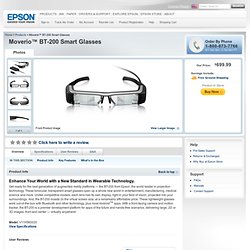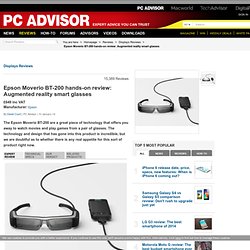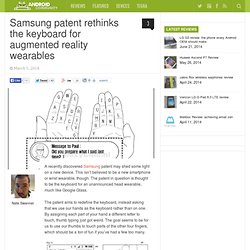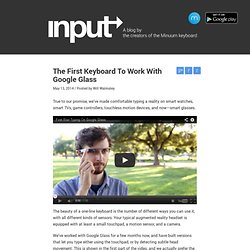

VDC's paper on wearables. Moverio™ BT-200 Smart Glasses. Product Info Back to top Get ready for the next generation of augmented reality platforms — the BT-200 from Epson, the world leader in projection technology.

These binocular, transparent smart glasses open up a whole new world in entertainment, manufacturing, medical science and more. Unlike competitive models, each lens has its own display, right in your field of vision, projected into your surroundings. Head Mounted Display - Personal 3D HDTV Viewer - HMZ-T3W Review. HDTV Like Never Before Now playing for your eyes and ears only—the wearable HDTV from Sony.

Connect your Blu-ray Disc™ player, gaming console or HDMI-capable PC all wirelessly and even hook up compatible mobile devices and smartphones to enjoy your favorite movies and games with a virtual 750" screen and virtual 7.1 surround sound—even in 3D. Immerse Yourself Slip on the wearable Head Mount Display to create your own personal movie theater or private game room and enjoy a 2D or 3D experience that's unlike anything you've ever seen. Connect with Mobile Devices Carry your favorite movies and games with you and watch them in your own private 150" simulated theater when you hook up your wearable HDTV directly to a tablet, PC, mobile device or smartphone. Cut the Cables The cordless convenience of WirelessHD™ combined with a versatile mobile battery makes the wearable HDTV the perfect device for maximum theater-like entertainment. Samsung explores a stripped-down take on wearable displays.
Lumus - Consumer Market Products. Enabling See-through, Wearable Displays Seeing through.

Seeing beyond. Offering a new way of living, working, communicating and viewing content (including Internet, email, video and video games) anywhere and anytime, Lumus-enabled displays take vision to the ultimate level by redefining what you see on the go: Super large high resolution screen anywhere you look, anywhere you are Video content and information in the blink of an eye Simultaneous connectivity to what you want to see & what you need to see Opening your eyes to whole new world of Augmented Reality Enabling natural-looking, discreet, lightweight, and portable eyewear Lumus products for the consumer market consist of: Wearable Display Development Kit Optical Engine module (for OEM) Wearable Display Development Kit.
Epson Moverio BT-200 hands-on review: Augmented reality smart glasses. The first thing that needs to be said about the £649 Epson Moverio BT-200 (available in May) is that they are not trying to be Google Glass.

They are about as different as Android smart glasses could possibly be. Whereas Google Glass is designed to be sleek and pretty hidden, the Moverio BT-200 comparatively is big, chunky and in your face. While the BT-200 weighs only 88g and are significantly smaller than its predecessor the BT-100, they are still not smaller enough to be described as natural feeling. Follow our coverage of CES 2014 live too. The Espon Moverio BT-200 works by showing you two tiny screens that are located in the middle of the lenses with a pixel resolution of 960 x 540. Theses smart glasses run Android 4.0.4 with the ability to download apps from the Epson store, and can be controlled mainly by an accompanying hand-held touchpad that is connected to glasses via a cable.
At £649 these glasses aren’t cheap, which begs the question: are they worth the money? Samsung patent rethinks the keyboard for augmented reality wearables. A recently discovered Samsung patent may shed some light on a new device.

This isn’t believed to be a new smartphone or wrist wearable, though. The patent in question is thought to be the keyboard for an unannounced head wearable, much like Google Glass. The patent aims to redefine the keyboard, instead asking that we use our hands as the keyboard rather than on one. By assigning each part of your hand a different letter to touch, thumb typing just got weird. The goal seems to be for us to use our thumbs to touch parts of the other four fingers, which should be a ton of fun if you’ve had a few too many.
The First Keyboard To Work With Google Glass. True to our promise, we’ve made comfortable typing a reality on smart watches, smart TVs, game controllers, touchless motion devices, and now—smart glasses.

The beauty of a one-line keyboard is the number of different ways you can use it, with all different kinds of sensors. Your typical augmented reality headset is equipped with at least a small touchpad, a motion sensor, and a camera. We’ve worked with Google Glass for a few months now, and have built versions that let you type either using the touchpad, or by detecting subtle head movement. This is shown in the first part of the video, and we actually prefer the head-tracking technique, which lets you feel like you’re looking at the letters that you want to type.
In the final portion of the video, we show some proof-of-concept techniques, which wouldn’t all necessarily work with the current version of Google Glass.